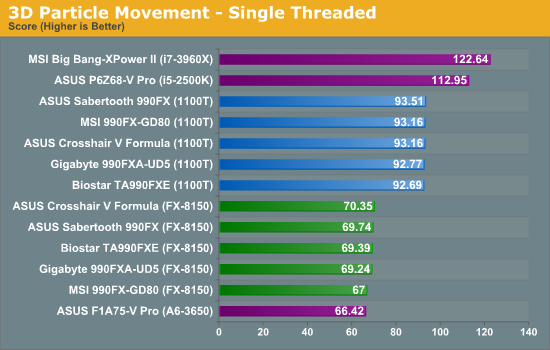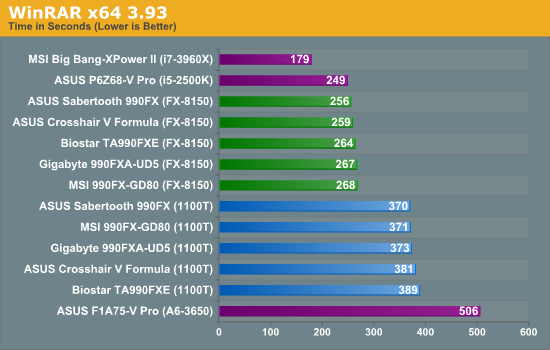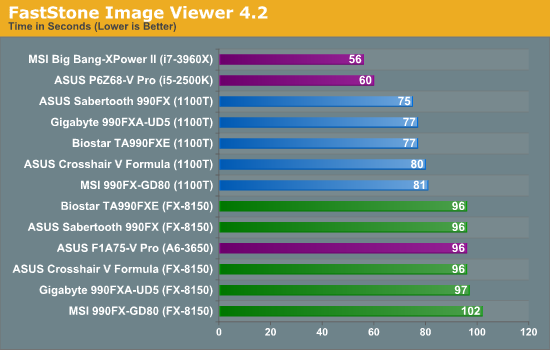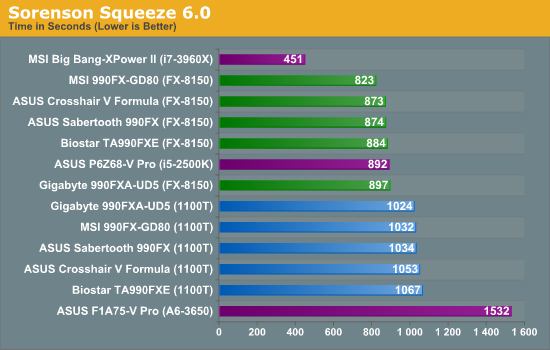990FX Motherboard Roundup with Thuban and Bulldozer – A Second Wind for ASUS, Gigabyte, MSI and Biostar
by Ian Cutress on April 5, 2012 11:00 AM EST3D Movement Algorithm Test
The algorithms in 3DPM employ both uniform random number generation or normal distribution random number generation, and vary in various amounts of trigonometric operations, conditional statements, generation and rejection, fused operations, etc. The benchmark runs through six algorithms for a specified number of particles and steps, and calculates the speed of each algorithm, then sums them all for a final score. This is an example of a real world situation that a computational scientist may find themselves in, rather than a pure synthetic benchmark. The benchmark is also parallel between particles simulated, and we test the single thread performance as well as the multi-threaded performance.

The biggest difference between the processors is shown in our CPU tests. In Single thread mode, we see characteristically that the FX-8150 is a lot lower than the X6-1100T even with Turbo Boost. This is because 3DPM is a wholly floating-point driven benchmark, and the FX-8150 is geared up to be an integer processor. In an ideal optimised world, all programs would use a hex base to calculate numbers (for example, highly optimised calculators of Pi), however the modern scientist may input code they understand to get results, even if it is floating point numbers. In this circumstance, Thuban is the way to go.

This is echoed even more strongly in the multi-threaded test, where the FX-8150 acts like a quad core (due to its FPU architecture) rather than an octo-core because of the floating point calculations in 3DPM.
WinRAR x64 3.93 - link
With 64-bit WinRAR, we compress the set of files used in the USB speed tests. WinRAR x64 3.93 attempts to use multithreading when possible.

WinRAR seizes the multi-threaded nature of the processors, and the FX-8150 acts better than the X6-1100T, but is still only on par with a quad-core i5-2500K. In terms of the motherboards, the Sabertooth once again takes credit here.
FastStone Image Viewer 4.2 - link
FastStone Image Viewer is a free piece of software I have been using for quite a few years now. It allows quick viewing of flat images, as well as resizing, changing color depth, adding simple text or simple filters. It also has a bulk image conversion tool, which we use here. The software currently operates only in single-thread mode, which should change in later versions of the software. For this test, we convert a series of 170 files, of various resolutions, dimensions and types (of a total size of 163MB), all to the .gif format of 640x480 dimensions.

Due to the single thread nature of FastStone, despite the increased frequency of the FX-8150, it's all about how the pipeline is managed. In this case, the MSI seems to fall by the wayside on both processors, while the Sabertooth again plays near the top.
Sorenson Squeeze 6.0 - link
Sorenson Squeeze is a professional video encoder, complete with a vast array of options. For this test, we convert 32 HD videos, each a minute long and approximately 42 MB in size, to WMV 512KBps format. Squeeze can encode multiple videos at once, one for each thread.

Video decoding and encoding is a purely optimised INT calculation unit affair, where multiple threads reign supreme. Thus we have the FX-8150 pulling ahead of the 1100T, and the MSI boards actually having a good showing.










57 Comments
View All Comments
mmstick - Thursday, April 5, 2012 - link
The primary problem with AMD FX is that in order to use the full power of the FPU the program needs to be compiled with FMA4 support, else it is only using half of the FPUs, thus making it a quad core. Secondly, many Windows-based programs are compiled with the Intel C+ compiler, so although the FX may support AVX and many other instructions, the compiled program sees it as a non-Intel CPU so it disables those instruction sets, allowing Intel CPUs to be optimized, and AMD CPUs to remain deoptimized. This is what happens when you are up against someone with the most market share, whom has the ability to dictate what instruction sets they want programmers to use. As well, when people say they are going to buy Intel CPUs instead because they claim AMD didn't make a good processor, why do you think they can't be on top of performance? Without R&D budget there isn't much that can be done, and when you face someone who practically owns a monopoly, that makes it even moreso harder to compete.Omoronovo - Thursday, April 5, 2012 - link
The IC++ compiler has not done that since 2010 when they were forced to settle their antitrust dispute with AMD.DigitalFreak - Thursday, April 5, 2012 - link
" This is what happens when you are up against someone with the most market share, whom has the ability to dictate what instruction sets they want programmers to use. As well, when people say they are going to buy Intel CPUs instead because they claim AMD didn't make a good processor, why do you think they can't be on top of performance? Without R&D budget there isn't much that can be done, and when you face someone who practically owns a monopoly, that makes it even moreso harder to compete."Waaaaah. It's always someone else's fault.
anubis44 - Friday, November 9, 2012 - link
"Waaaaah. It's always someone else's fault."Well, sometimes it really IS someone else's fault. If the mafia had it in for you, and cut your brake cables and burnt your house down when you weren't looking, you'd say it's 'someone else's fault' too. Intel's blackmail and threats to suppliers who used AMD processors kinda screwed AMD over just a tad.
That said, I think now that Jim Keller is back at AMD and head of AMD's CPU division, it won't be too long before AMD is seriously back in the game.
Monkeysweat - Thursday, April 5, 2012 - link
I saw them on some of the benchmarks, why didn't you post them along side the AMD benchies for gaming?If we are looking at a roundup of the best of what AMD and it's partners have to offer, I'd like to see what the competing team brings to the table,, just leave em stock and even let the AMD ones get overclocked.
I wouldn't even worry about cherry picking the Intel combos,, just something random.
Beenthere - Thursday, April 5, 2012 - link
AMD has not abandoned the highend CPU market. Their focus may be broadening but that does not mean they will discontinue discrete highend desktop CPUs for at least several years. Eventually everyone except a small group will use APUs as they will deliver the best performance/value proposition. Only extremists will bother with a discrete CPU/GPU with higher power consumption, increased heat and little practical benefit for mainstream users.Articuno - Thursday, April 5, 2012 - link
It's a pretty nice chipset and the lower tier boards are quite cost-effective. Just wish Bulldozer was competitive with Intel, let alone their last gen chips.Mathieu Bourgie - Thursday, April 5, 2012 - link
Thank you for this article Ian.Are there any chance that we'll see a review of the newer FX-6200 CPU or at least have data for it in the CPU bench? Considering that it's 500MHz faster than the model that it's replacing and no major site (or any that I can see) did a review of it, it'd be interesting to see how it performs.
I'm curious to see if it's a valid alternative, in any way, for $170, vs the Intel Core i5-2300 ($180).
I don't expect any miracle for gaming performance, but for workstation workloads (Photoshop, video editing and the like), who knows?
Thanks,
Mathieu
cosminmcm - Thursday, April 5, 2012 - link
There is a review at pcper, a good one. The processor is pretty weak, nothing exciting there. Thuban walks all over it.Mathieu Bourgie - Friday, April 6, 2012 - link
Thanks, I didn't see that.Quite disappointing indeed.
Here's about that Piledriver or Trinity are more competitive.